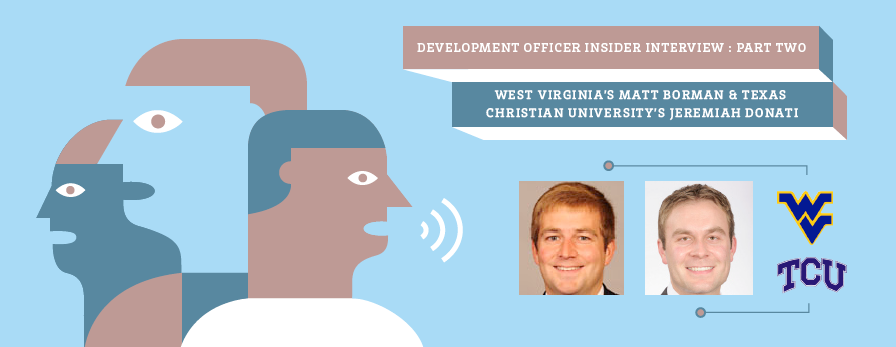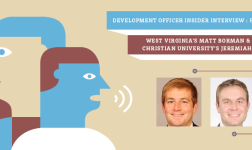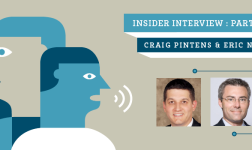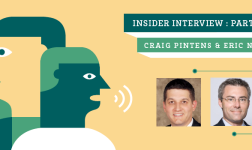Winthrop Intelligence is pleased to host another Insider Interview, letting key leaders in college sports go deeper by passing off the mic, for one-on-one expert interviews.
Fundraising and development are the focus of our conversation with expert Insiders Matt Borman—Associate Athletic Director and Executive Director at West Virginia University—and Jeremiah Donati—Associate Athletics Director for Development at Texas Christian University. Both are members of NAADD—the National Association of Athletic Development Directors, the industry organization that provides educational and networking opportunities for those in college athletics development and fund raising.
Matt and Jeremiah have both overseen major fundraising campaigns, are well respected leaders in field, and are considered to be two of the most successful development officers working in college athletics.
We wanted to hear a little bit about the skills necessary to be an effective fundraiser, how technology is changing the development landscape, and learn about some innovative strategies for connecting with donors.
Listen to the interview:
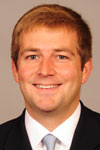 Matt Borman – West Virginia
Matt Borman – West Virginia 
Senior Associate Athletic Director/Executive Director
Have there been any development strategies that you guys have tried in the past couple years that maybe haven’t gone the way you thought they would? What are some of the things that you’ve learned from those?
 Jeremiah Donati – Texas Christian University
Jeremiah Donati – Texas Christian University 
Associate Athletics Director for Development
Well, we went through our massive re-seating for our new stadium. This is before the 2012 season. And I think, by and large, I would say it was a success. However, not everyone is going to jump and down and tell you how great of a success it was. What you’re going to hear are the people who are dissatisfied and, frankly, you are going to get complaints; it’s a very emotional process.
One of the biggest lessons I learned from that process and probably any type of reseating is that the number one goal is to hopefully maximize revenue. Also of great important, be fair to your fans. We wanted communicate clearly with our fans. We used direct mail, email, we even conducted a town hall meeting. You can never do that enough. I really and firmly believe you cannot over-communicate to your fan base, especially when you have a massive project or undertaking.
And at the time, we were not utilizing social media like we are today. It would be interesting to go through that process again and really sit down with football, sit down with marketing, and go to oversee the main social media handles for the athletic department and say, “Okay, let’s get together and form a unified strategy here so that we can hit more people.” Hindsight is 20/20, but I think if we could go back and do the reseating, we would have taken a different approach in that regard.
 Matt Borman – West Virginia
Matt Borman – West Virginia 
Senior Associate Athletic Director/Executive Director
We just finished a reseating as well, in July. And I think we used some benchmarking and used some peer policies and some research to make sure that we were trying to put together the best reseating process as possible. I think talking to you guys, other schools in the Big 12, and other peers regionally really helped us out. We did some of the things that you just talked about.
We got the idea from schools like you about the town halls, the Twitter, the communicating through blast emails and mailings, but making sure that we communicated nonstop throughout that process. And it wasn’t going to go perfectly. But we feel like because we did communicate very well, that it made it a little bit easier process for us. At the end of the day, everyone has asked us how that reseating went? Obviously, you had people that were upset. But the two items that pleased me and I think we can really judge ourselves on is how many compliments on our process we received.
We also didn’t have many people miss appointments. We had a good process in place and we communicated well. Everything else took care of itself. We honestly thought that it was a success and we appreciated being able to talk to schools like TCU, Kansas, Kansas State, Virginia, Virginia Tech to see what they went through.
Continuing our little reseating tangent, I did have one more question for you in reseating. We ended up allowing some donors to keep seats that they had previously been in. Did you guys have any ways for donors to do that or was it a complete reseating for you guys at TCU?
 Jeremiah Donati – Texas Christian University
Jeremiah Donati – Texas Christian University 
Associate Athletics Director for Development
For football, it was a complete reseating. And the reason it was is because every seat was new. The stadium was entirely brand new, so there were literally no seats to go back to. That would’ve been something I’ll be calling you about when we reseat in basketball, once we finish that capital project. All of the seats will be new.
Overall, was it a complete reseating or were there just groups that were reseated?
 Matt Borman – West Virginia
Matt Borman – West Virginia 
Senior Associate Athletic Director/Executive Director
It was a complete reseating, but we did give some donors the opportunity to maintain a certain number of seats in certain areas. For example, in our VIP seats, which we call our “800” seats closest to the floor, you were able to maintain four of those if you were a $25,000 donor. And that sounds like a huge gift and it’s our top level, but we did get individuals stepping up to that level to make sure that they could maintain four seats.
And sometimes it was a win-win, because they might have had eight seats down there before. They’re reducing the number of seats they had down there, yet they’re increasing their gifts. So, situations like that were very positive for us. At the end of the day, I do think we made a good decision letting some donors keep seats. It gave them a donor level to try to attain and make sure that if they were happy where they were.
And to be honest, some people went up to that level, maintained their seats and they could have probably gotten better seats if they had just entered into the reseating. But you and I both know, sometimes it’s just about maintaining exactly where you want. There’s tradition there. They just do not want to move. At the end of the day, having that option was good for us.
 Jeremiah Donati – Texas Christian University
Jeremiah Donati – Texas Christian University 
Associate Athletics Director for Development
Reseating, we found that it’s a very emotional deal for many people. They associate themselves with those seats. So, to go through that process, there must be a huge burden lifted off your shoulders with a project where you have so much emotion tied to seats. I know we certainly went through that.
 Matt Borman – West Virginia
Matt Borman – West Virginia 
Senior Associate Athletic Director/Executive Director
What were some of the ways you all took advantage of your move to the Big 12 and how did you try to translate that into more dollars raised?
 Jeremiah Donati – Texas Christian University
Jeremiah Donati – Texas Christian University 
Associate Athletics Director for Development
We were very fortunate in regards to the move to the Big 12. One, because it coincided perfectly with the opening of our new stadium. We really had kind of a perfect storm. We launched a massive big 2012 campaign that encompassed reseating, new club seats, new suites.
So, the demand for not only TCU football, but TCU athletics was at kind of an all-time fever pitch for us. Frankly, there was so much momentum because for us these were old traditional rivals for us, going back to the Southwest Conference days. So, playing Texas and Baylor and Texas Tech and schools that we have so much historical and geographic relation with us is huge for our fan base.
With conferences we had been in before, it was difficult for fans to get to. But they were so excited about being able to drive to some of these places, being able to get the office pool started up against their friends who went to Texas, or Texas Tech, or Baylor, or Kansas, or Oklahoma, or West Virginia.
We just tried to manage everyone’s expectations. We hired an advertising company to do the big 2012 campaign. We spent a lot of money to make sure this was done right. And we were fortunate that it was well-worth it for us. We had a big result for us as far as gift revenue. We had all-time highs for annual funds for overall giving. A lot of that is attributed to the stadium.
A lot of it was timing and just making sure that we were doing our best to communicate what this meant for everyone. I’m curious to hear how you guys at West Virginia took advantage of it.
What was it like going to a different conference where you had different opponents that you’ve never really competed with before?
 Matt Borman – West Virginia
Matt Borman – West Virginia 
Senior Associate Athletic Director/Executive Director
Well, our message definitely had to be a little bit different than for you all. I think some of our donors were probably very comfortable with where we were in the Big East and being able to drive to some of the away games and they loved the Big East basketball tournament in New York.
But after we were able to describe our vision and our decision to go to the Big 12, the majority of them saw the need and were on board with that. I think one of our biggest challenges right off the bat was connecting with the donors in Philadelphia, and New York, and Boston. Some of our alums moved up the coast and are within a day’s drive of Morgantown. And being able to connect with them at least once a year when we got to those areas and played football or basketball was great.
And now, it really takes some scheduling for our coaches to be able to get up there and connect with those donors. We can always go visit them and we still do. But there’s something about having a game up there and being able to feel more of a part of it when you can see your team.
But at the same time, there was some downside for our donors in Texas and Oklahoma. And you may say “Does West Virginia really have alums out there?” We definitely do because of our great engineering and petroleum engineering program. They were just ecstatic that we’re going to be out there multiple times a year.
Fundraising-wise and what we did kind of on a smaller level, we started a Big 12 transition fund. Every one of our major gift officers, when they’re in front of a donor and the topic of Big 12 comes up. Sometimes, that donor isn’t necessarily on board with wanting to give to the new football facility. Or they don’t necessarily have an interest in endowment. It gave us another option for our major gift officers to really sell that move to the Big 12 and say “They’re going to be expensive. We have to take on by making this move and giving people the opportunity to pledge over a five-year period to the Big 12 fund.”
That helps a little bit. We also took our spring caravan right after the announcement was going to be made and put a little Big 12 flavor to it. And Barry Switzer and Billy Sims came in from Oklahoma and spoke at a couple of events. It was very well-attended and they did a great job kind of introducing us to some of the Big 12 culture.
We also had Frank Martin lined up, but then, about a week before we had him scheduled to come to West Virginia to speak and be with one of his good buddies, Coach Huggins, he left for South Carolina. We had to cancel that. Those are some of the things we did in trying to take full advantage of the exciting move and getting us into a very stable conference.

